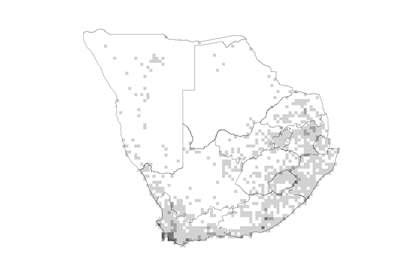 Species distribution and density. Darker squares represent higher density of members of this family. |
Introduction
Carrot family
A large, readily identifiable family with many well-known culinary and medicinal species. The alternative name, Umbelliferae, refers to the conspicuous umbellate compound inflorescence typical for the family.
Distribution
This is a cosmopolitan family with increased diversity in temperate regions, particularly in the northern hemisphere. Within southern Africa, the Western Cape and the eastern escarpment show the highest diversity in species.
Number of genera in the world
ca. 453
Number of species in the world
ca. 3 750
Number of genera in the Flora of southern Africa region
48
Number of species in the Flora of southern Africa region
240
Well-known southern African genera
Afrosciadium, Alepidea, Annesorhiza, Apium, Centella, Conium, Heteromorpha, Polemannia
Growth forms
Mostly herbaceous annuals, also biennials or perennial herbs and trees. Many species have basal rosettes but others may be stoloniferous or even cushion plants.
Habitats
Found in grassland, fynbos, open scrub, forest and moist places next to streams and rivers; some real aquatics, but also in dry environments.
Flagship species
Heteromorpha arborescens (parsley tree; wildepietersieliebos [A]; umbangandlala [X, Z]) is a shrub or small tree with glossy leaves. Dried, hollowed stems of this plant are used by the Xhosa as musical instruments. In folklore it is planted at the gathering places and kraals of chiefs to ensure loyalty towards the leader. It is medicinally used to treat abdominal pains. An infusion of leaves is used to deworm children and infusions of roots are used for coughs and dysentery. The smoking of dried plants is said to relieve headaches. (Photo: NC).
Significance of the family
This family is an important food source as the leaves, stems and roots are utilised, e.g. carrots (*Daucus carota). Many are used as culinary herbs, e.g. parsley (*Petroselinum crispum) or as spices, e.g. coriander (*Coriandrum sativum). Many species have herbal and medicinal properties and the essential oils of some are used in the perfume industry. Some genera (*Eryngium, *Astrantia, Bupleurum and *Ammi) are cultivated for the flower industry and others as ornamentals for their architectural inflorescences.
Diagnostic characters
Aromatic herbs or trees, the stems with distinct pith (sometimes hollow stem or internodes). Leaves alternate , much-divided with a sheath at the base �. Stipules absent. Flowers in simple or compound umbels , usually flat-topped. Calyx reduced. Petals 5 , free. Stamens 5, free. Inferior ovary with 2 separate styles borne on a cushion-like structure . Fruit dry, separating into 2 mericarps, each with 5 lengthwise ridges or wings. (Photos : NC; : JK).
Did you know?
Hemlock (*Conium maculatum) was used in ancient Greece to execute condemned prisoners (e.g. Socrates).